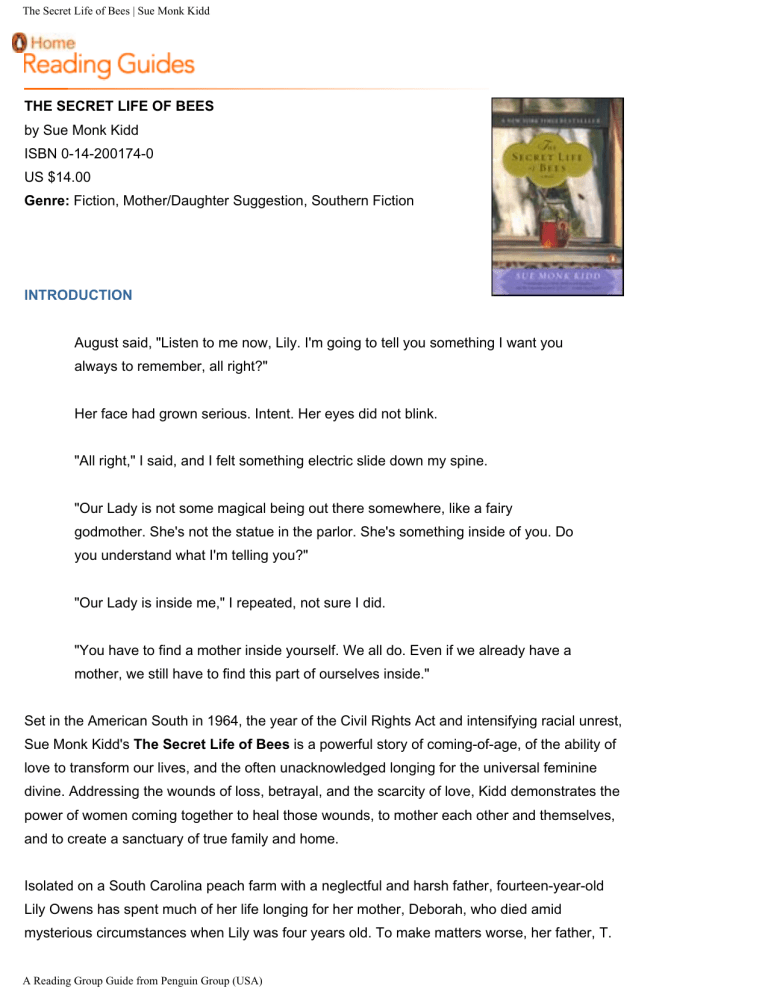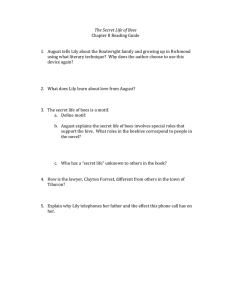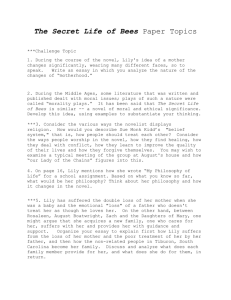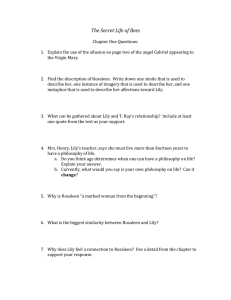
The Secret Life of Bees | Sue Monk Kidd THE SECRET LIFE OF BEES by Sue Monk Kidd ISBN 0-14-200174-0 US $14.00 Genre: Fiction, Mother/Daughter Suggestion, Southern Fiction INTRODUCTION August said, "Listen to me now, Lily. I'm going to tell you something I want you always to remember, all right?" Her face had grown serious. Intent. Her eyes did not blink. "All right," I said, and I felt something electric slide down my spine. "Our Lady is not some magical being out there somewhere, like a fairy godmother. She's not the statue in the parlor. She's something inside of you. Do you understand what I'm telling you?" "Our Lady is inside me," I repeated, not sure I did. "You have to find a mother inside yourself. We all do. Even if we already have a mother, we still have to find this part of ourselves inside." Set in the American South in 1964, the year of the Civil Rights Act and intensifying racial unrest, Sue Monk Kidd's The Secret Life of Bees is a powerful story of coming-of-age, of the ability of love to transform our lives, and the often unacknowledged longing for the universal feminine divine. Addressing the wounds of loss, betrayal, and the scarcity of love, Kidd demonstrates the power of women coming together to heal those wounds, to mother each other and themselves, and to create a sanctuary of true family and home. Isolated on a South Carolina peach farm with a neglectful and harsh father, fourteen-year-old Lily Owens has spent much of her life longing for her mother, Deborah, who died amid mysterious circumstances when Lily was four years old. To make matters worse, her father, T. A Reading Group Guide from Penguin Group (USA) The Secret Life of Bees | Sue Monk Kidd Ray, tells Lily that she accidentally killed her mother. Lily is raised by Rosaleen, her proud and outspoken African-American nanny. When Rosaleen attempts to exercise her newly won right to vote, she is attacked by the three worst racists in town and is thrown into jail. Lily is determined to save Rosaleen and finally escape her own father as well. Seizing the moment, she springs Rosaleen from jail, and the two set out across South Carolina in search of a new life. Their destination is Tiburon, South Carolina—a town they know nothing about except that in a box of Lily's mother's belongings there is a cryptic picture of a black Virgin Mary with the words "Tiburon, South Carolina" written on the back. There they are taken in by three black beekeeping sisters who worship the Black Madonna. It is here, surrounded by the strength of the Madonna, the hum of bees, and a circle of wise and colorful women, that Lily makes her passage to wholeness and a new life. Captured by the voice of this Southern adolescent, one becomes enveloped in the hot South Carolina summer and one of most tumultuous times the country has ever seen. A story of mothers lost and found, love, conviction, and forgiveness, The Secret Life of Bees boldly explores life's wounds and reveals the deeper meaning of home and the redemptive simplicity of "choosing what matters." In the end, though she cannot find the mother she lost, Lily discovers and comes to terms with her mother's past, finds a hive of new mothers, and falls in love with the great universal mother. ABOUT SUE MONK KIDD Sue Monk Kidd is the author of two widely acclaimed nonfiction books, The Dance of the Dissident Daughter and When the Heart Waits. She has won a Poets and Writers Award for the story that began this novel, as well as a Katherine Anne Porter Award. Two of her short stories, including an excerpt from The Secret Life of Bees, were selected as notable stories in Best American Short Stories. The Secret Life of Bees, her first novel, was nominated for the prestigious Orange Prize in England. AN INTERVIEW WITH SUE MONK KIDD A Reading Group Guide from Penguin Group (USA) The Secret Life of Bees | Sue Monk Kidd The novel is set in South Carolina in 1964. Did you experience the South in the 1960s? In 1964 I was an adolescent growing up in a tiny town tucked in the pinelands and red fields of South Georgia, a place my family has lived for at least two hundred years, residing on the same plot of land my great-great-grandparents settled. The South I knew in the early sixties was a world of paradoxes. There was segregation and the worst injustices, and at the same time I was surrounded by an endearing, Mayberryesque life. I could wander into the drugstore and charge a cherry Coca-Cola to my father, or into the Empire Mercantile and charge a pair of cheerleader socks to my mother, and before I got home my mother would know what size Coke I'd drunk and what color socks I'd bought. It was an idyllic, cloistered, small-town world of church socials, high school football games, and private "manners lessons" at my grandmother's. Yet despite the African-American women who prominently populated the world of my childhood, there were enormous racial divides. I vividly remember the summer of 1964 with its voter registration drives, boiling racial tensions, and the erupting awareness of the cruelty of racism. I was never the same after that summer. I was left littered with memories I could not digest. I think I knew even back then that one day I would have to find a kind of redemption for them through writing. When I began writing The Secret Life of Bees, I set it during the summer of 1964 against a civil rights backdrop. It would have been impossible for me to do otherwise. What parts of The Secret Life of Bees were drawn from your own life experience? Once, after I gave a reading of the scene where T. Ray makes Lily kneel on grits, someone in the audience asked if my father had ever made me kneel on grits. She couldn't imagine, she said, anyone making that up! I explained that not only had I never knelt on grits, or even heard of kneeling on grits before it popped into my head while writing the novel, but that T. Ray is the exact opposite of my father. I conjured most of the novel straight out of my imagination, inventing from scratch, yet bits and pieces of my life inevitably found their way into the story. Like charm school. Lily wanted to go, believing it was her ticket to popularity. As an adolescent, I went to charm school, where I learned to pour tea and relate to boys, which, as I recall, meant giving them the pickle jar to unscrew, whether it was too hard for me or not. And there is the fact that Lily and I both wanted to be writers, rolled our hair on grape juice cans, refused to eat grits, and created model fallout shelters for our seventh-grade science projects. We also both had nannies, but otherwise Lily and I are more different than alike. My favorite piece of personal history that turned up in the novel is the honeybees that lived in a wall of our house when I was growing up. We lived in a big country house in Georgia, where bees lived for many years inside the wall of a guest bedroom, squeezing through the cracks to fly about the house. I remember my mother cleaning up puddles of honey that seeped out, and the unearthly sound of bee hum vibrating through the house. The whole idea for the novel A Reading Group Guide from Penguin Group (USA) The Secret Life of Bees | Sue Monk Kidd began one evening when my husband reminded me that the first time he'd visited my home to meet my parents, he'd awakened in amazement to find bees flying about the room. After he told that story, I began to imagine a girl lying in bed while bees poured through cracks in her bedroom walls and flew around the room. I couldn't get the image out of my head. I began asking myself: Who is this girl? What is the desire of her heart? That anonymous girl became Lily Melissa Owens, lying there, yearning for her mother. Are any of the characters modeled on people you know? I'm inclined to say that no character in the novel is modeled on a real person, but nothing is ever that simple, is it? As I wrote about Rosaleen, I could hear my own nanny's voice in my head. She had a colorful way with words, and some of her sayings found their way into Rosaleen's mouth. For instance my nanny used to say that if you put her husband's brain into a bird, the bird would fly backward. You may recall that Rosaleen said exactly the same thing about her husband. Like Rosaleen, my nanny was also a connoisseur of snuff. She carried around a snuff cup and had a distinct manner of spitting it that Rosaleen inherited. Other than a few borrowed traits and sayings, however, the two of them weren't that much alike. While I borrowed some trivial details from my own adolescence and gave them to Lily, she was essentially her own unique creation, just as T. Ray, Deborah, Zach, Gabe, and Neil were. All of them sprang to life the same way—conjured from anonymity. As for August, May, June, and the Daughters of Mary, I'm sure I drew on amorphous memories of growing up around a lot of wonderful Southern, African-American women. As a child, I loved to listen to their stories. But I wasn't thinking of any particular one of them as I wrote. The inspiration for August came mostly from a vision I carry inside, of feminine wisdom, compassion, and strength. I just kept trying to imagine the woman I would've wanted to find if I'd been in Lily's complicated situation. In the past you have written books of memoir. Would you describe the transition you made from writing nonfiction to fiction? Will you write another nonfiction book in the future? When I began writing at the age of thirty, my dream was to write fiction, but I was diverted from that almost before I started. I became enticed by the notion of writing memoir. For over a decade I was compelled by the idea of turning my own life into narratives. My books The Dance of the Dissident Daughter A Reading Group Guide from Penguin Group (USA) The Secret Life of Bees | Sue Monk Kidd and When the Heart Waits were narratives of my spiritual experience. I think many people need, even require, a narrative version of their life. I seem to be one of them. Writing memoir is, in some ways, a work of wholeness. I thought I would go on writing only nonfiction the rest of my life. Ah, but never underestimate the power of a dismissed dream. I think there must be a place inside of us where dreams go and wait their turn. In the early nineties, my old dream of writing fiction resurfaced. To be honest, initially I was both compelled and repelled by its unexpected return. Compelled because it was a genuine impulse from deep within and had a lot of passion attached to it. Repelled because I was, to put it bluntly, afraid I couldn't do it. The dilemma forced me to come to terms with my fear. I took on the role of apprentice fiction writer. I read voluminous amounts of literary fiction and set about studying the craft of fiction writing. More important, I practiced—writing short stories and rewriting them. Now, of course, I can't imagine my life apart from writing fiction. Will I, then, write another book of memoir? Oh, undoubtedly. I still have a need to create a narrative of my life. To keep writing it until I see how it turns out. What was the process of writing the novel? How long did it take to complete it? The novel began as a short story in 1993. At the time I wrote it, I wanted to develop the story into a novel, but I'd only just begun to write fiction, and felt I needed more time as an apprentice before taking on a novel. I put the story aside. Years later I was invited to read my fiction at the National Arts Club in New York. I dug out my short story, "The Secret Life of Bees." After the reading, I was again filled with the desire to turn it into a novel. I still didn't feel ready, but I figured I might never feel ready, and meanwhile I wasn't getting any younger. It took me a little over three years to complete the novel. The process of writing it was a constant balancing act between what writing teacher Leon Surmelian referred to as "measure and madness." He suggested that writing fiction should be a blend of these two things. That struck me as exactly true. On one hand, I relied on some very meticulous "measures," such as character studies, scene diagrams, layouts of the pink house and the honey house. I had a big notebook where I worked out the underlying structure of the book. I relied more heavily, however, on trying to conjure "madness," which I think of as an inexplicable and infectious magic that somehow flows into the work. Before I started the novel, I created a collage of images that vividly caught my attention. They included a pink house, a trio of African-American women, and a wailing wall. I propped the collage on my desk with no idea how, or even A Reading Group Guide from Penguin Group (USA) The Secret Life of Bees | Sue Monk Kidd whether, these things would turn up in the novel. Inducing "madness" also meant that I often left my desk to sit on the dock overlooking the tidal creek behind our house and engage in a stream of reverie about the story. I considered this earnest work. How does having a sisterhood of women make a difference? Have you experienced such a community? Isak Dinesen, who wrote Out of Africa, once said, "All sorrows can be borne if we put them in a story or tell a story about them." Ever since I first read that line, I've carried it with me. When women bond together in a community in such a way that "sisterhood" is created, it gives them an accepting and intimate forum to tell their stories and have them heard and validated by others. The community not only helps to heal their circumstance, but encourages them to grow into their larger destiny. This is what happened to Lily. She found a sanctuary of women where she could tell her story, and have it heard and validatedÑan act that allowed her not only to bear her sorrow but transform it. I have been part of several communities of women over the years. Each of them was created simply because we wanted a place to tell our deepest stories. In every case we found that there is a way of being together that sustains us, and now and then, if we are lucky, returns us to ourselves. Where did your interest in Black Madonnas come from? Are there actual Black Madonnas in the world? If so, what is the story behind them? How did a Black Madonna end up in your novel? For a number years I studied archetypal feminine images of the divine and grew fascinated with how the Virgin Mary has functioned as a Divine Mother for millions of people across the centuries. It was during this period that I inadvertently stumbled upon an array of mysterious black-skinned Madonnas. They captivated me immediately, and I began to explore their history, mythology, and spiritual significance. Approximately four hundred to five hundred of these ancient Madonnas still exist, most in Europe. They are among the oldest Madonna images in the world, and their blackness is purportedly not related to race or ethnic origins, but has to do with obscure symbolic meanings and connections to earlier goddesses. I traveled to Europe to see some of the Black Madonnas and found them to be images of startling strength and authority. Their stories reveal rebellious, even defiant sides. Black Madonnas in Poland and Central America have been the rallying images for oppressed peoples struggling against persecution. A Reading Group Guide from Penguin Group (USA) The Secret Life of Bees | Sue Monk Kidd I decided the Black Madonna had to make an appearance in my novel. I had no idea, though, what a starring role she would end up with. I thought she would be a small statue, sitting quietly in the background of the story. Then I visited a Trappist monastery, where I came upon a statue of a woman that had once been the masthead of a ship. It was deeply scarred and didn't look particularly religious. I asked a young monk about it. He told me she'd washed up on the shores on a Caribbean island and wound up in an antique shop. She wasn't really the Virgin Mary but was purchased and consecrated as Mary. I fell in love with the masthead Mary. I imagined a masthead Black Madonna in the pink house. I pictured fabulous black women in grand hats dancing around her, coming to touch their hands to her heart. I understood in that moment that here was Lily's mother, a powerful symbolic essence that could take up residence inside of her and become catalytic in her transformation. Just like that, the Black Madonna became a fullblown character in the novel. Did you know anything about bees and beekeeping before you wrote the novel? How did you learn so much about bees? I knew that bees could live inside the wall of a bedroom in your house. Other than that, I didn't know much at all. I began my bee education by reading lots of books. There's a mystique about bees, a kind of spell they weave over you, and I fell completely under it. I read bee lore and legend that went back to ancient times. I discovered bees were considered a symbol of the soul, of death and rebirth. I will never forget coming upon medieval references which associated the Virgin Mary with the queen bee. I'd been thinking of her as the queen bee of my little hive of women in the pink house, thinking that was very original, and they'd already come up with that five hundred years ago! Books couldn't tell me everything I needed to know, so I visited an apiary in South Carolina. Inside the honey house, I sketched all the honey-making equipment, trying to get a handle on how they worked. There seemed to be thin veneer of honey everywhere, and my shoes stuck slightly to the floor when I walked, something I could never have learned from a book. When the beekeepers took me out to the hives, I was unprepared for the rush of fear and relish I experienced when the lid on the hive was lifted. I became lost in a whirling cloud of bees. So many, I could hardly see. The scent of honey drifted up, bee hum swelled, and the smoke meant to calm the bees rose in plumes all around us. Beekeeping, I discovered, is a thoroughly sensual and courageous business. I got through my bee education without a single sting. The first time August took Lily to the hives, she told her, "Don't be afraid, as no life-loving bee wants to sting you. Still, don't be an idiot; wear long sleeves and long pants." Did you know how the novel would end when you began it? Did you consider having T. Ray change his ways by the end, beg for Lily's forgiveness, and admit that he shot A Reading Group Guide from Penguin Group (USA) The Secret Life of Bees | Sue Monk Kidd Deborah? When I began the novel, not only did I have no idea of the ending, but I was clueless about the middle. My idea extended only as far as Lily springing Rosaleen free and the two of them running away to Tiburon. I didn't know where they would end up once they got there. At that point the beekeeping Boatwright sisters had not materialized. After I wrote the scene where Lily and Rosaleen walk into Tiburon, I was stuck. I happened to flip through a book where I came upon a quote by Eudora Welty: "People give pain, are callous and insensitive, empty and cruel... but place heals the hurt, soothes the outrage, fills the terrible vacuum that these human beings make." It struck me clearly that I needed to create a place that would do that for Lily. I glanced over at my collage, at the trio of African-American women, and it simply dropped into my head—Lily would find sanctuary in the home of three black beekeeping sisters. As I neared the conclusion, I knew some aspects of the ending but not all of them. I knew that it would not be in T. Ray's character to change his ways, beg Lily's forgiveness, and admit shooting Deborah. There was never a possibility in my mind of that happening. I knew from the beginning that Lily was actually the one responsible for her mother's death. It was a tragic thing, but it made her situation, her emotional life, more complex and layered. And it made her journey of healing so much more essential and powerful. No, the part I hadn't figured out was where Lily would end up. Would she go back to the peach farm with T. Ray? Would she stay at the pink house? Initially, I couldn't grasp how to work it out so that she would get to stay. I was influenced, too, by my impression (right or wrong) that "happy endings" in literary novels were often sneered at. I decided she would have to go back to the peach farm with T. Ray. Then one night I had a dream in which August came to me, complaining about my idea for an ending. "You must let Lily stay with her 'mothers,'" she told me. I woke a little awed and a lot relieved. I knew immediately that I would take August's advice. It was what I'd really wanted all along. Do you have plans to follow this novel with a sequel? What are you working on now? This might sound peculiar, but after I finished the novel, I actually felt homesick for the pink house. I missed being with Lily, August, May, June, Rosaleen, and the Daughters of Mary. I moped around for a couple of weeks as if all my friends had moved away. I was sure that I would never revisit the story. I didn't want to risk tampering with the world I'd created. I wanted to freeze Lily at this moment of her life, fourteen forever, living in the pink house. Then I went on book tour, and the most frequently asked question that I got from readers was: Will you write a sequel? I was surprised by how strongly readers wanted to know what would happen to the characters. I started off saying that a sequel was really not a possibility. Still the question kept coming, along with disappointed looks when I gave my answer. I began saying, well okay, it's not likely, but I'll think about it. And that's as far as I've gotten. I'm thinking. A Reading Group Guide from Penguin Group (USA) The Secret Life of Bees | Sue Monk Kidd Right now I'm working on a second novel set in the Low Country of South Carolina. All I can say is that I'm immersed once again with characters, in a place apart, one that I will undoubtedly miss one day the way I missed the pink house. DISCUSSION QUESTIONS 1. Were you surprised to learn that T. Ray used to be different, that once he truly loved Deborah? How do you think Deborah's leaving affected him? Did it shed any light on why T. Ray was so cruel and abusive to Lily? 2. Had you ever heard of "kneeling on grits"? What qualities did Lily have that allowed her to survive, endure, and eventually thrive, despite T. Ray? 3. Who is the queen bee in this story? 4. Lily's relationship to her dead mother was complex, ranging from guilt to idealization, to hatred, to acceptance. What happens to a daughter when she discovers her mother once abandoned her? Is Lily right—would people generally rather die than forgive? Was it harder for Lily to forgive her mother or herself? 5. Lily grew up without her mother, but in the end she finds a house full of them. Have you ever had a mother figure in your life who wasn't your true mother? Have you ever had to leave home to find home? 6. What compelled Rosaleen to spit on the three men's shoes? What does it take for a person to stand up with conviction against brutalizing injustice? What did you like best about Rosaleen? 7. Had you ever heard of the Black Madonna? What do you think of the story surrounding the Black Madonna in the novel? How would the story be different if it had been a picture of a white Virgin Mary? Do you know women whose lives have been deepened or enriched by a connection to an empowering Divine Mother? 8. Why is it important that women come together? What did you think of the "Calendar Sisters" and the Daughters of Mary? How did being in the company of this circle of females transform Lily? A Reading Group Guide from Penguin Group (USA) The Secret Life of Bees | Sue Monk Kidd 9. May built a wailing wall to help her come to terms with the pain she felt. Even though we don't have May's condition, do we also need "rituals," like wailing walls, to help us deal with our grief and suffering? 10. How would you describe Lily and Zach's relationship? What drew them together? Did you root for them to be together? 11. Project into the future. Does Lily ever see her father again? Does she become a beekeeper? A writer? What happens to Rosaleen? What happens to Lily and Zach? Who would Zach be today? A Reading Group Guide from Penguin Group (USA)




